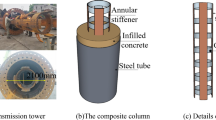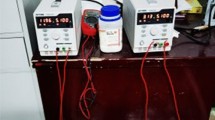Abstract
Detailed study has been carried out on the load carrying capacity of cement stabilized rammed earth (CSRE) circular columns under axial compression. Tests on CSRE cylinders and columns were performed to determine the effects of concentric axial loading and slenderness ratio; and stress reduction factors were assessed. A comparative study was made between the ultimate compressive strength (σ u) of columns determined using tangent modulus theory and experimental values. Furthermore, the validity of using masonry design rules for the design of CSRE columns was also assessed. The result shows that with increasing slenderness ratio the load carrying capacity of columns decreases. The ultimate compressive strength of column predicted by tangent modulus theory tend to converge with experimental values at higher slenderness ratio and the masonry codal predictions are observed to be un-conservative as compared to experimental reduction factors. Lastly, the characteristic strength determined for columns yields relatively higher safety factor and indicates that it is possible to construct a single storey load bearing houses when designed properly.









Similar content being viewed by others
Abbreviations
- E c :
-
Compaction energy in kg cm/cm3
- E t :
-
Tangent modulus at failure in MPa
- h :
-
Height of column in mm
- P :
-
Average load in kN
- P au :
-
Average ultimate load in kN
- P u :
-
Ultimate load in kN
- δ al :
-
Average lateral displacement in mm
- δ av :
-
Average vertical displacement in mm
- δ l :
-
Lateral displacement in mm
- λ :
-
Height to diameter ratio or slenderness ratio
- σ :
-
Average compressive strength in MPa
- σ cr :
-
Critical stress or buckling strength in MPa
- σ u :
-
Ultimate compressive strength in MPa
- ε :
-
Average compressive strain
- γ f :
-
Factor of safety for dead loads
- γ m :
-
Material strength variations and workmanship factors
References
ASTM (2010) Standard guide for design of earthen wall building systems. E2392/E2392 M-10. ASTM International, West Conshohocken
ASTM (2012) Standard test methods for laboratory compaction characteristics of soil using standard effort. D698-12. ASTM International, West Conshohocken
Bleich F (1952) Buckling strength of metal structures. McGraw-Hill, New York
BS 5628 Part 1 (1992) Structural use of unreinforced masonry. British Standard Institute, London
Bui QB, Morel JC, Hans S, Walker P (2014) Effect of moisture content on the mechanical characteristics of rammed earth. Constr Build Mater 54:163–169
Easton D (1982) The rammed earth experience, 1st edn. Blue Mountain Press, Wilseyville
Giamundo V, Lignola GP, Prota A, Manfredi G (2014) Nonlinear analyses of adobe masonry walls reinforced with fiberglass mesh. Polymers. 6(2):464–478
Hall M (2002) Rammed earth: traditional methods, modern techniques, sustainable future. Build Eng 77(11):22–24
Indian Standard (1989) Specification for 43 grade ordinary portland cement. IS 8112. Indian Standard Institution, New Delhi
Indian Standard (1995) Determination of liquid and plastic limit. IS 2720 (part 5). Indian Standard Institution, New Delhi
Indian Standard (1995) Specification for methods of test for soils-grain size analysis. IS 2720 (part 4). Indian Standard Institution, New Delhi
Indian Standard (1998) Improving earthquake resistance of earthen buildings—guidelines. IS 13827. Indian Standard Institution, New Delhi
Indian Standard (2002) Code of practice for structural use of unreinforced masonry. IS 1905. Indian Standard Institution, New Delhi
Indian Standard (2002) Determination of water content-dry density relation using light compaction. IS 2720 (part 7). Indian Standard Institution, New Delhi
Jaquin P (2008) Analysis of historic rammed earth construction. Ph.D. thesis, School of Engineering, Durham University
Jayasinghe C (1999) Alternative building materials and methods for Sri Lanka. Ph.D. thesis, Department of Civil Engineering, University of Moratuwa
Jayasinghe C, Kamaladasa N (2007) Compressive strength characteristics of cement stabilized rammed earth walls. Constr Build Mater 21:1971–1976
Kotak T (2007) Constructing cement stabilised rammed earth houses in Gujarat after 2001 Bhuj earthquake. In: Proceedings of international symposium on earthen structures. Interline Publishers, Bangalore, pp 62–71
Maniatidis V, Walker P (2008) Structural capacity of rammed earth in compression. J Mater Civ Eng 20(3):230–238
Middleton GF (1987) Bulletin 5. Earth wall construction, 4th edn. CSIRO Division of Building, Construction and Engineering, North Ryde [Revised by Schneider LM (1992)]
Minke G (2000) Earth construction handbook. The building material earth in modern architecture. WIT Press, Southampton
New Zealand Standard (NZS) (1998) Engineering design of earth buildings. NZS No. 4297. New Zealand Standard, Wellington
Reddy VBV, Kumar PP (2009) Compressive strength and elastic properties of stabilised rammed earth and masonry. Masonry Int 22(2):39–46
Reddy VBV, Kumar PP (2011) Structural behavior of story-high cement-stabilized rammed earth wall under compression. J Mater Civ Eng 23(3):240–247
Sahlin S (1971) Structural masonry. Prentice Hall, Upper Saddle River
Southwell RV (1932) On the analysis of experimental observations in problems of elastic stability. Proc Royal Soc London Ser A 135:601–616
Standards Australia (2002) Australian earth building handbook, HB 195. Standards Australia International, Sydney
Tibbets JM (2001) Emphasis on rammed earth—the rational. Interaméricas Adobe Builder 9:4–33
Tripura D, Sharma R (2014) Bond behavior of bamboo splints in cement-stabilized rammed earth blocks. Int J Sustain Eng 7(1):24–33
Tripura D, Singh KD (2014) Characteristic properties of cement-stabilized rammed earth blocks. J Mater Civ Eng. doi:10.1061/(ASCE)MT.1943-5533.0001170
Turanli L, Saritas A (2011) Strengthening the structural behavior of adobe walls through the use of plaster reinforcement mesh. Constr Build Mater 25:1747–1752
Verma PL, Mehra SR (1950) Use of soil-cement in house construction in the Punjab. Indian Concr J 24(4):91–96
Walker P, Keable R, Martin J, Maniatidis V (2005) Rammed earth design and construction guidelines. BRE Press, Bracknell
Acknowledgments
The authors would like to thank Pratik Sundar and Bandana Debbarma for their support during the entire process of casting and testing of the test specimens.
Author information
Authors and Affiliations
Corresponding author
Rights and permissions
About this article
Cite this article
Tripura, D.D., Singh, K.D. Behavior of cement-stabilized rammed earth circular column under axial loading. Mater Struct 49, 371–382 (2016). https://doi.org/10.1617/s11527-014-0503-4
Received:
Accepted:
Published:
Issue Date:
DOI: https://doi.org/10.1617/s11527-014-0503-4




